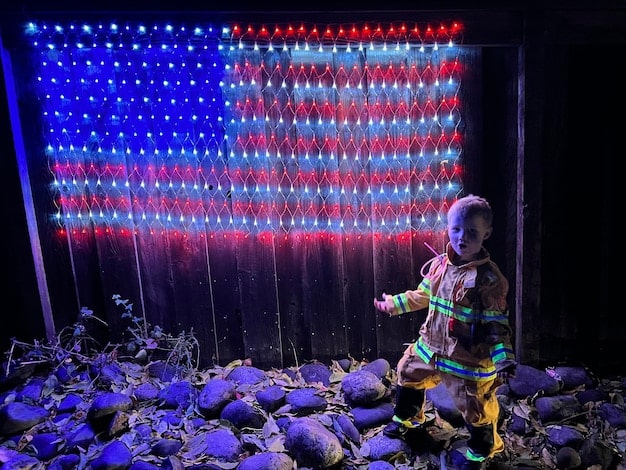Exclusive: Stray Kids’ US TV Debut – Behind the Scenes Negotiations

Exclusive: Inside the Negotiations for Stray Kids’ Upcoming US Television Appearance reveals the intricate discussions and strategic decisions leading to the highly anticipated television debut of the globally acclaimed K-Pop group in the United States.
The anticipation is palpable as Stray Kids, the sensational K-Pop group, gears up for their first major US television appearance. But what goes on behind the scenes to make such a monumental event happen? This article delves into the exclusive: Inside the Negotiations for Stray Kids’ Upcoming US Television Appearance, revealing the intricate dance between agencies, networks, and the artists themselves.
Unveiling the Initial Discussions
The journey to a US television debut for a K-Pop group begins long before the cameras start rolling. It all starts with preliminary discussions, exploring the potential and gauging mutual interest. Let’s explore the genesis of these exciting plans.
The First Contact
The initial contact often involves talent agencies reaching out to US television networks. These agencies act as intermediaries, showcasing the potential of K-Pop artists like Stray Kids to a wider audience.
Assessing Mutual Interest
Networks evaluate various factors, including the artist’s popularity, fanbase size in the US, and overall appeal to their target demographic. Simultaneously, the artist’s agency assesses the network’s reach, viewership, and suitability for the group’s image.
- Market Analysis: The evaluation of Stray Kids’ current popularity in the US market.
- Target Audience: Matching the group’s appeal with the network’s viewership demographics.
- Strategic Alignment: Ensuring the network’s values align with the group’s brand and image.
Ultimately, these initial discussions lay the groundwork for more concrete negotiations. Successfully aligning these foundational elements is key to setting the stage for a successful collaboration.
Key Players in the Negotiation Process
Several key players are involved in orchestrating a K-Pop group’s US television appearance. Talent agencies play a pivotal role, but they are not the only entities at the negotiation table. Let’s break down who the key players are.
Talent Agencies
Talent agencies act as the primary representatives for Stray Kids, advocating for the group’s best interests and negotiating terms that align with their career goals.
US Television Networks
US television networks, such as NBC, CBS, and ABC, have the final say on programming decisions, including which artists to feature and the specifics of their appearances.
Public Relations Firms
Public relations firms work to manage the image of both the artist and the network, ensuring positive media coverage and public perception of the partnership.

The dynamics between these key players can be complex, requiring careful coordination and open communication to reach mutually beneficial agreements. Each entity brings unique perspectives and priorities to the table, making effective negotiation skills essential.
Negotiating the Appearance Format
One of the most critical aspects of negotiating a US television appearance for Stray Kids is determining the appearance format. This involves deciding what role the group will play on the show and how their performance or segment will be structured.
Performance Segments
Performance segments are a common format, showcasing the group’s musical talents to a wide audience. Negotiations often focus on song selection, stage design, and the overall presentation.
Interview Segments
Interview segments allow Stray Kids to connect with viewers on a personal level. Discussions revolve around the topics covered, the tone of the interview, and the allotted time.
Special Appearances
Special appearances may include guest roles in comedy sketches, participation in reality TV segments, or involvement in charitable initiatives. These formats offer diverse opportunities, but require careful consideration to align with the group’s brand.
Considering these different formats and tailoring an appearance that resonates with both the group’s capabilities and the network’s programming strategy is key to success. The final format choice reflects a strategic decision aimed at maximizing impact and audience engagement.
Financial Considerations and Contractual Agreements
The financial aspects of a US television appearance can be intricate, involving various fees, royalties, and revenue-sharing arrangements. Securing a fair and favorable contract is crucial for both Stray Kids and their agency.
Appearance Fees
Appearance fees are the upfront payments that Stray Kids receive for their participation in the television show. These fees are typically negotiated based on the group’s popularity and the scope of their involvement.
Royalties and Licensing
Royalties and licensing agreements cover the use of Stray Kids’ music, image, and likeness in the broadcast and related promotional materials. These agreements ensure that the group receives appropriate compensation for their intellectual property.
Revenue Sharing
In some cases, revenue-sharing arrangements may be negotiated, allowing Stray Kids to receive a percentage of the profits generated by the television show. This is more common for appearances that feature significant integration of the group’s content.

Negotiating these financial terms is a delicate process that requires expertise in entertainment law and a clear understanding of the market value that Stray Kids bring to the table. A well-structured contract will protect the group’s interests and ensure fair compensation for their work.
Addressing Creative Control and Brand Alignment
Maintaining creative control and ensuring brand alignment are paramount concerns for Stray Kids when negotiating a US television appearance. The group wants to ensure that their appearance reflects their artistic vision and aligns with their established image.
Content Approval
Content approval clauses give Stray Kids the right to review and approve the content of their segments, including scripts, song selections, and visual elements. This ensures that the creative direction aligns with their preferences.
Image Protection
Image protection clauses safeguard Stray Kids’ reputation by preventing the use of their image in a way that could be perceived as controversial or damaging. This includes stipulations against associating the group with inappropriate content or endorsements.
Artistic Input
Artistic input provisions allow Stray Kids to contribute their own ideas and perspectives to the creative process. This can include suggesting modifications to the script, proposing alternative performance ideas, and shaping the overall tone of their segments.
- Brand Integrity: Ensuring that the group’s brand is consistently represented in all promotional materials.
- Creative Vision: Protecting the group’s artistic choices and creative direction.
- Public Perception: Maintaining a positive image and reputation among fans and the general public.
Achieving a balance between the network’s needs and Stray Kids’ creative autonomy is crucial for a successful partnership. By addressing these concerns proactively, the group can ensure that their US television appearance enhances their brand and resonates with their fans.
Finalizing the Agreement and Preparing for the Debut
Once all the key terms have been negotiated and agreed upon, the final step is to formalize the agreement and begin preparations for Stray Kids’ US television debut. This involves detailed planning, logistical coordination, and creative execution.
Contractual Formalities
The finalized agreement is meticulously reviewed by legal teams from both sides to ensure that it reflects all negotiated terms and complies with applicable laws and regulations. Once approved, the contract is signed, officially binding both parties.
Logistical Planning
Logistical planning involves coordinating travel arrangements, securing necessary visas and permits, and arranging accommodations for Stray Kids and their support team. This also includes scheduling rehearsals, wardrobe fittings, and makeup sessions.
Creative Execution
Creative execution encompasses all aspects of preparing the group’s performance or segment, from choreographing dance routines to designing stage sets. Close collaboration between Stray Kids, their creative team, and the network’s production team is essential for bringing the vision to life.
The culmination of these efforts paves the way for Stray Kids to captivate audiences with their US television debut. The meticulous planning and attention to detail ensures a seamless and memorable performance, marking a significant milestone in their global career.
| Key Aspect | Brief Description |
|---|---|
| 🤝 Initial Discussions | Exploring potential and gauging mutual interest between Stray Kids and US networks. |
| 🎤 Appearance Format | Deciding on performance segments, interview segments, or special appearances. |
| 💰 Financial Terms | Negotiating appearance fees, royalties, and potential revenue sharing. |
| ✨ Creative Control | Ensuring brand alignment and artistic integrity through content approval. |
Frequently Asked Questions
▼
A US television debut is significant as it exposes Stray Kids to a broader audience, potentially increasing their fanbase and solidifying their global presence in the competitive K-Pop industry.
▼
The primary negotiators for Stray Kids are typically their talent agency representatives who advocate for the group’s interests and manage the terms of their television appearances.
▼
Appearance fees are influenced by the group’s popularity, fanbase size in the US, the scope of their performance, and the overall value they bring to the television network.
▼
K-Pop groups ensure creative control through content approval clauses in their contracts, allowing them to review and approve scripts, song selections, and visual elements to maintain brand alignment.
▼
Logistical challenges include coordinating travel, securing visas and permits, arranging accommodations, and scheduling rehearsals to ensure a seamless and successful television debut in the US.
Conclusion
The negotiations for Stray Kids’ upcoming US television appearance are a complex and multifaceted process, involving numerous stakeholders and intricate considerations. By understanding the key elements of these negotiations, fans and industry observers can gain a deeper appreciation for the hard work and strategic planning that goes into bringing K-Pop to the global stage.





